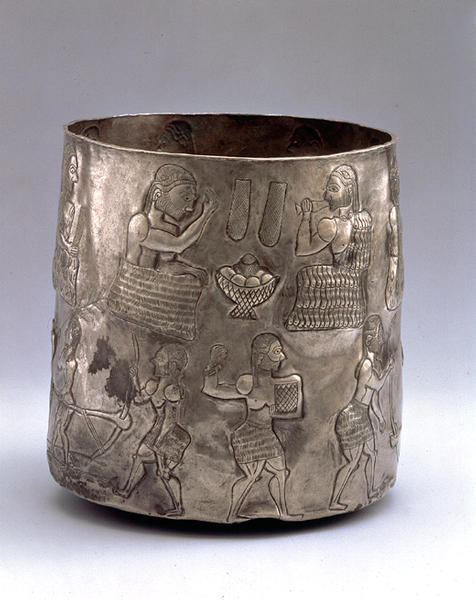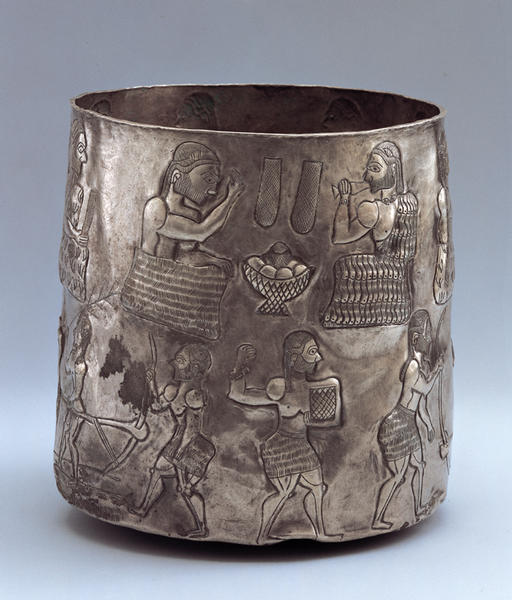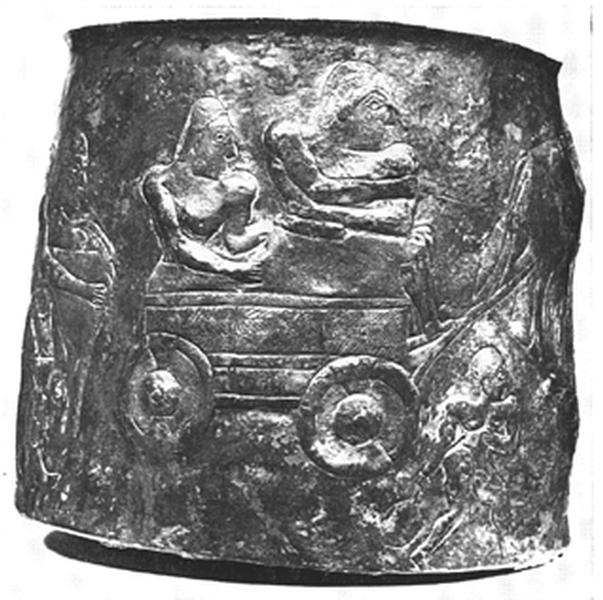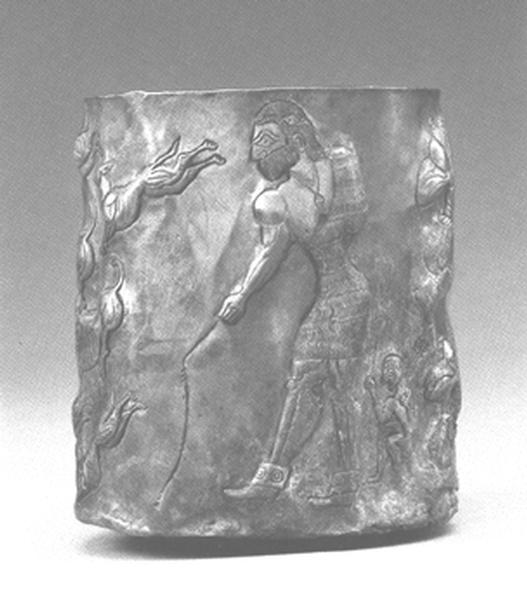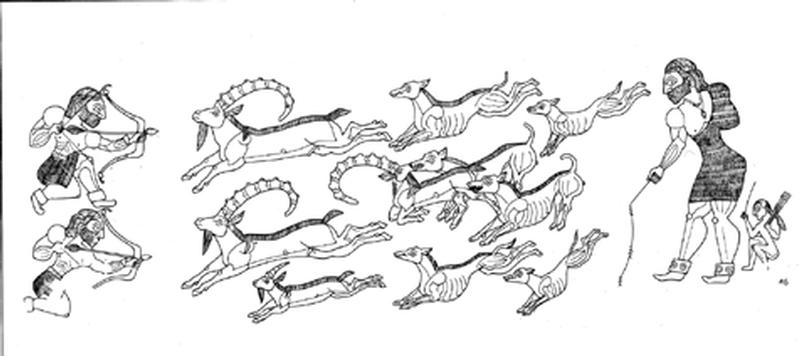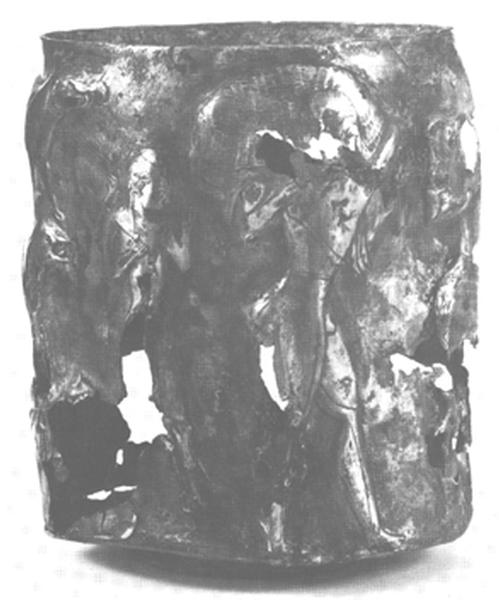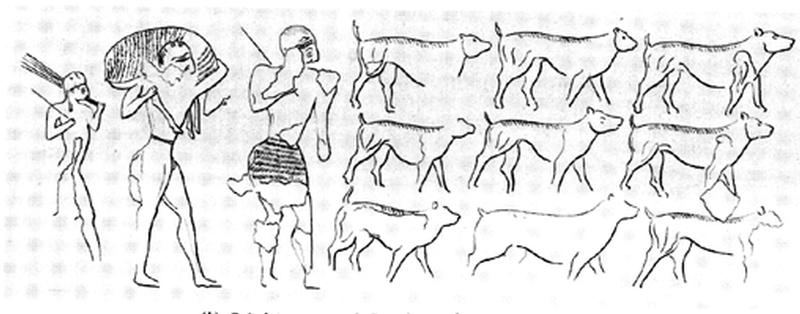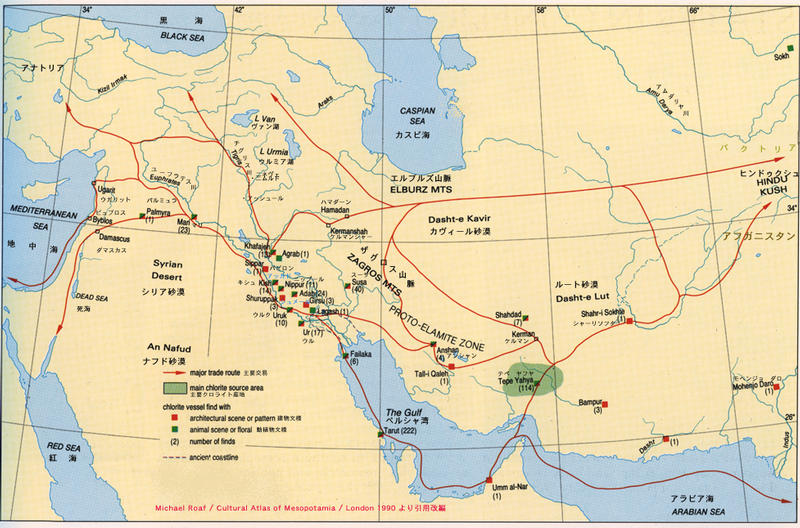Cylindrical Cup with Agricultural and Ceremonial Scene
- Bactria
- Late 3rd - early 2nd millennium B.C.
- Silver
- H-12.6 D-9.9
Catalogue Entry
A fine metalworking tradition appears to have developed in western Central Asia in the late third to the early second millennium B.C. Based on comparisons with excavated pottery types and with finds in the so-called Fullol hoard of objects from northern Afghanistan,1 a number of gold and silver vessels have been attributed to Bronze Age Bactria. Perhaps the most exceptional are cylindrical silver vessels with elaborate figural scenes executed in low relief with incised details, all of which may come from a single workshop.
On this example,2 bearded and moustached male banqueters wearing fillets in their bound long hair are seated in a row above men and boys plowing a field. The main personage in this upper row, who faces left, is distinguished by an elliptically shaped bead on his fillet; he also wears a necklace and bracelet with similar beads, all bearing hatched patterns that might suggest veined stone such as agate. A robe with very clearly rendered individual tufts covers one arm entirely and envelops the rectangular form of his lower body. The man's exposed right arm is raised to hold a tall footed beaker to his mouth (this is the only figure to have a defined mouth). In front of him are a footed fruit bowl, a pair of tall vessels, and a second seated figure wearing a robe with a herringbone pattern. The proper right arm of this figure is raised toward the main personage. Also part of this banqueting scene are five other seated male figures, their garments distinguished alternatively by individual tufts or horizontal rows of hatchings that form herringbone patterns. Some figures hold beakers and one rests a hand on a large altar-like rectangular object with a crosshatched pattern.
In the scene below, two plows are held by long-haired men wearing short kilts with herringbone patterns. Before them, nude youths holding branches attempt to keep two pairs of oxen under control. Another male figure holds a square object-perhaps a box or even a drum-under one arm, and raises the other one. The figures stand on freshly seeded earth; between the animals is an object with a wavy-line pattern and seed-like elements along the top edge. Although difficult to interpret, this could indicate landscape in viewed from above or a vessel in profile.
While iconographic elements such as the garments connect the imagery on this cup to the art of Mesopotamia and Elam, certain aspects of style are very distinctive. In particular, a strong interest in the placement of human and animal figures in space is manifest. The oxen in the background are darkened with hatched lines to clearly distinguish them from those in the foreground.3 The muscular shoulders of the human figures may be depicted in profile or in three-quarter view, and they may have one rather than two nipples showing. The two plows, one seen from the front and the other from the back, are placed behind one and in front of the other nude youth. An interest in the use of patterning to define the textures of garments and objects is also evident.
In style, this cup is closely related to a silver vessel in the Levy-White collection.4 The main personage in a hunting scene there bears a close resemblance to the main figure on the present cup. He is bearded, with a well-delineated mouth, and has elliptical beads both in his hair and around his neck. A figure with similar features appears on another cup, which depicts the aftermath of a successful hunt.5
JA
1. Amiet 1988b, pp. 136, 161, describes this hoard (like the "Astrabad treasure" from Iran with related material) as a contrived collection of objects from clandestine excavations in northern Afghanistan; see Tosi and Wardak 1972, pp. 9-17.
2. See Amiet 1986, pp. 328-29, fig. 202; Pottier 1984, pp. 73, 212, pl. xxx, fig. 250; Deshayes 1977, pp. l04-5; Amiet 1988b, p. 136, fig. 9.
3. This convention is also used on a cylindrical cup in the Louvre, with a chariot scene: see Amiet 1988b, p. 163, fig. 6.
4. See Pittman 1990, pp. 43-44, no. 30.
5. Amiet 1986, pp. 326-27, fig. 201.
Catalogue Entry(Bac#007)
Late 3rd‐early 2nd millennium B.C.
Silver
H. 12.2-12.6 cm, Dia. 9.5-9.9 cm
Designs are incised into an upper and lower register on the walls of this silver cup, with the upper register showing a ritual scene and the lower register showing a farming scene with oxen. The upper register scene has also been thought to be a banqueting scene, but of the eight seated figures, only the figure on the far right facing to the left is shown with food before him and raising his cup to his mouth. This figure is also shown with his head, neck and wrists wearing jewels that appear to be onyx, and higher grade of clothing, both clearly symbols of his high rank. The figure directly in front of this high ranking figure is shown in a position of obeisance, and he has jewelry only on his head. The other six figures have no jewelry. These devices clearly are thought to indicate the respective ranks of these figures. This offertory or welcoming posture can also be seen in the last two figures in this row.
The two oxen in the lower register are shown pulling plows during a tilling and planting scene. The small naked figure wields a stick to urge on the oxen, and there are clear divisions drawn between the figures holding onto the plow and those sowing seeds. There are similar examples of silver cups from this period with hunting scenes, and in the same manner, those who are thought to be high-ranking figures are shown adorned with jewelry thought to be made of onyx. This body expression with short kilted skirt and emphasized musculature was characteristic of the western Central Asia through Eastern Iran from the 3rd millennium BC through the 2nd millennium BC. The arranged hair expression on the forequarters of the oxen and the musculature of the back legs are also unique to Bactrian culture. The ruins of a massive Bactrian fort of this same period have been excavated, along with temples inside the fort and large numbers of weapons, and we can thus imagine the existence of a ruler who was powerful both in politics and in military might, all while acting as the head cleric of the religion. These people did not have writing, but this vessel clearly depicts one aspect of their society.
